-

人教版高中英语必修2Cultural Relics说课稿2篇
Ⅲ. Analysis of the teaching material:The topic of this unit is cultural relics. Students are quite interested in topics about different cultures around the world. This is the second period of the whole unit. As a reading class, the passage mainly talks about the history of the amber room (how it was made, sent as a gift, lost and rebuilt).According to the new national curriculum, when teaching reading, much emphasis should be put on training the students’ reading skills.Ⅳ. Teaching objectives1. Language objectives:1) Students are required to master the key words and phrases occurred in the passage (e.g. amazing, decorate, belong, in return, less than etc.)2) Students are required to learn the attributive clause and acquire the sentence pattern.2. 1) Students are required to describe a certain thing by using the new sentence patterns.2) Students are required to master two kinds of reading skills—skimming and scanning, and learn to use them in their daily reading.3. 1) Students are required to know the history of the amber room.2) Students are required to appreciate cultural relics and understand the importance of protecting them.Ⅴ. Teaching important and difficult points1) the new words, phrases, and sentence pattern in the course of reading.2) Teaching difficult point: Help the students master two kinds of reading skills—skimmingand scanning and learn to apply them in daily use.Ⅵ. Teaching methods:Task-based method & Top-down model Ⅶ. Teaching aids: PPT, pictures, blackboard Ⅷ. Teaching procedure:

人教版高中英语必修2Wildlife Protection说课稿3篇
When it comes to the students’ studying methods, I'd like to introduce my Ss first. The Ss have a good command of basic language points. They’re interested in learning English, and they take an active part in English class, so they will have fun in autonomous, cooperative and inquiry learning. I will just serve as a guide, showing them the way to explore how to make more progress in their English learning.Now it’s time for the most important stage of this lesson. My teaching procedures are arranged as follows:Step1.Leading-in (3 minute)Play a video of a wide variety of wildlife to introduce my topic. Step2. Speaking (12 minutes)We will use our textbook Page25. Let the Ss fast read the short paragraph to warm up. Ask them to talk about the report on some endangered wildlife in China with the dialogue patterns on the screen. Lastly, I will invite some groups to demonstrate their dialogues about saving wildlife in China.Step3.English play (3 minutes)Watch another video in praise of their excellent performance just now. It’s about Jack Chen’s(成龙)and Yang Ziqiong’s wildlife protection.Step4. Listening (twice 13 minutes)This time, I’ll ask the Ss to fill in the blanks of the monologue of the 2 movie stars above. Step5.Discussion (3 minutes)Which would you like to choose to wear, clothes made of cotton, artificial leather or animal skins? Why ?Step6. Summary (3 minutes)1. If there were no wildlife, there wouldn’t exist human beings. If the buying stops, the killing can, too.2. Animals are our friends. To love animals is to love ourselves. Stop hunting, killing and destroying wildlife.3. Let’s live in harmony with all the living things in the world. Step7. Music appreciation (3 minutes)Let the Ss appreciate the song Earth Song by Michael Jackson. Last but not the least, I will show you my blackboard design.

人教版高中英语必修4Women of achievement说课稿4篇
Good morning, distinguished judges:It’s my honor to talk about my teaching ideas with you. Today my topic is Women of Achievement. My presentation consists of six parts: the analysis of teaching material and student, teaching aims, key and difficult points, teaching and studying method, teaching procedures and blackboard design.First, let’s focus on the analysis of teaching material. This lesson is from New Senior English for China Student’s Book 4 Unit 1, the reading part. The main topic of the passage is the introduction of a student of Africanwildlife. After this lesson, the students will learn more information about her studying chimps in Africa, and their reading and speaking abilities can be developed as well.The next part is the analysis of students. My students are in senior high students. They have learnt English for many years, they’ve known many words and sentences, but their speaking and reading abilities are still not very good. So I will practice their speaking and reading abilities through different exercises.According to the New Standard Curriculum and the present situation, I set the teaching aims as follows: firstly, knowledge aims. Students can grasp some new words, such as worthwhile, move off. Moreover, students can understand the content of the passage and get familiar with the topic of studying chimps in wildlife. Secondly, ability aims. Students can use reading strategies such as skimming and scanning in reading process. Thirdly, emotional aims. Students can have the awareness of protecting animals and care about animals.Based on the above analysis, the key point of this lesson is to get the main idea and the detailed information from the passage; the difficult point is to talk about the wildlife protection and use reading strategies.

人教版高中英语必修3Healthy Eating说课稿4篇
Language learning needs a context, which can help the learners to understand the language and then can product comprehensible output, so computer has the advantages to make the materials attractive.Part 3 Learning MethodsTask-based, self-dependent and cooperative learningPart 4 Teaching ProcedureStep One Lead-in“Interest is the best teacher.” Therefore, at the very beginning of the class, I should spark the students’ mind to focus on the centre topic “the band”. I’ll show some pictures of food to attract their attention and then bring some questions.Question:What kind of food they like?What should go into a good meal?The answers must relate to the diet. After this, the students will be eager to know something about a balance diet and this is the very time to naturally lead the class into Step 2Step 2 Reading for information: skimming and scanning In this step, I use Task-based Language Teaching method, which can give students a clear and specific purpose while skimming and scanning the context.Task 1 General ideaThe students will be asked to just glance at the title and the pictures of the passage, and then guess what they will read in the text. And they’ll be divided into groups of four to have a discussion.The purpose is to inspire the students to read actively, not passively. In addition, the task is to develop the students’ reading skill by making prediction and to encourage the students to express their thoughts in English and cooperate with each other.Task 2 Main idea of each paragraphCooperative learning can raise the students’ interest and create an atmosphere of achievement. Based on this theory, I divide the whole class into 4 groups to skim the whole text and get the main idea of each paragraph.

人教版高中英语必修5First aid说课稿6篇
In this class, I have 3 teaching aims, that is, knowledge aims, ability aims and emotion aims.1) Knowledge-Teach students new words and expressions, such as temporary, bleed,sprain choke, first aid, fall ill and so on.-Enable students to have a better understanding for some basic knowledge of first aid.2) Ability-Train students’ speaking, reading and writing abilities by different teaching activities, such as skimming, comprehending, team work, role play, retelling and writing.-Develop students’ reading strategy on how to move general idea to specific information.3) Emotion-Promote students’ awareness of giving first aid.- Cultivate students’ creativities.Then let’s come to my teaching methods and activities.III. Teaching methods and activities:To achieve different teaching aims, various kinds of teaching methods and activities will be adopted throughout this period, such as TBL (task-based learning), skimming, team work, brainstorm and others, which can offer students opportunities to fulfill tasks in which they can use language to achieve a specific outcome.IV. Teaching aids:Computer and blackboardV. Teaching important points:1) Make students have a clear mind for the structure of the text.2) Help students understand the theme of the text.VI. Teaching difficulties:1) So many new words may affect students’ understanding.2) How to get students to know about the functions of the skin and thecauses, characteristics and treatments for different degree burns,and the knowledge about giving first aid. VII. Blackboard design:

人教版高中英语必修5Making the news说课稿4篇
今天我们来介绍一下必修五第四单元的授课方式。这个单元的题目是Making the news。应该是学生比较感兴趣的话题,学生往往对新闻工作充满好奇,所以我们可以利用这个机会多设计一些师生互动和学生互动,来激发起学习的积极性,提高学习效率。同时我们可以利用这个单元不仅帮助学生掌握语言知识,培养语言能力,同时让其了解新闻工作的重要性,培养起社会智能感。这个单元分为六个课时,它的教学目标是这样的:语言目标是掌握词汇表中的常用单词和短语,掌握倒装句的一些基本用法。 技能目标是能初步掌握约会的基本句型并在真实的场景下正确运用。新闻报道类文章的写作技能。采访的基本规范和沟通技能。情感目标是对新闻报道的客观性和真实性有更好的理解。对新闻记者的职业有更深入的了解,并能体会其工作的重要性。下面我们来介绍一下第一课时的授课方式,第一课的教学目标是这样的第一课时的教学目标语言目标:单词:Occupation, journalist, editor, photographer, curious, personality, enthusiasm
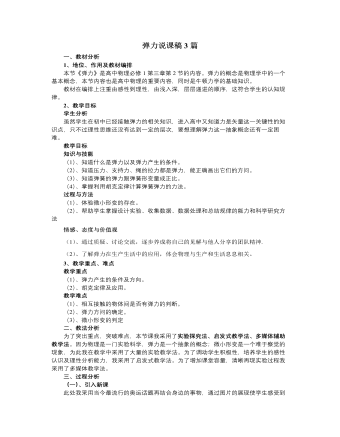
人教版新课标高中物理必修1弹力说课稿3篇
基于以上分析,为使本堂课围绕重点、突破难点,同时让学生在课堂教学中能力得到提高,我设计如下教学过程。(一)创设情景认识形变由同学们已有的形变知识入手,引入新课。教师演示:①弹簧的压缩形变;②弹簧的拉伸形变③视频播放:竹竿形变、钢丝的扭转形变。得出形变的概念及各类形变。[设计意图:我从生活情景中引入新课,是为了激发学生的好奇心,为学生学习重点和难点内容作铺垫。]设问:摩天大楼在风的吹拂下会不会摆动,发生形变吗?演示微小形变放大实验:由于这种形变不容易观察,会使学生产生疑问:到底有没有发生形变?解决的办法是微小形变的演示实验。为什么光点会往下移?让学生带着问题思考后得出结论:是由于桌面发生了形变,但是形变不明显。为后面解决压力和支持力都是弹力做好铺垫。[设计意图:使学生知道“放大”是一种科学探究的方法。]
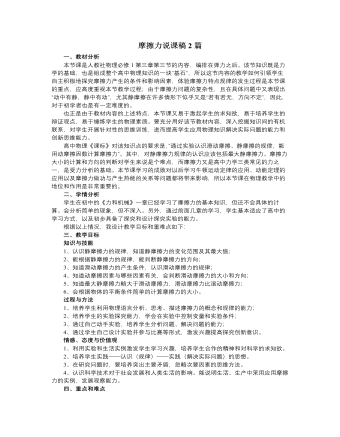
人教版新课标高中物理必修1摩擦力说课稿2篇
本节课是人教社物理必修1第三章第三节的内容,编排在弹力之后。该节知识既是力学的基础,也是组成整个高中物理知识的一块“基石”,所以这节内容的教学如何引领学生自主积极地探究摩擦力产生的条件和影响因素,体验摩擦力特点规律的发生过程是本节课的重点,应高度重视本节教学过程;由于摩擦力问题的复杂性,且在具体问题中又表现出“动中有静,静中有动”,尤其静摩擦在许多情形下似乎又是“若有若无,方向不定”,因此,对于初学者也是有一定难度的。也正是由于教材内容的上述特点,本节课又易于激起学生的求知欲,易于培养学生的辩证观点,易于锤炼学生的物理素质。要充分用好该节教材内容,深入挖掘知识间的有机联系,对学生开展针对性的思维训练,进而提高学生应用物理知识解决实际问题的能力和创新思维能力。高中物理《课标》对该知识点的要求是,“通过实验认识滑动摩擦、静摩擦的规律,能用动摩擦因数计算摩擦力”。其中,对静摩擦力规律的认识应该包括最大静摩擦力。
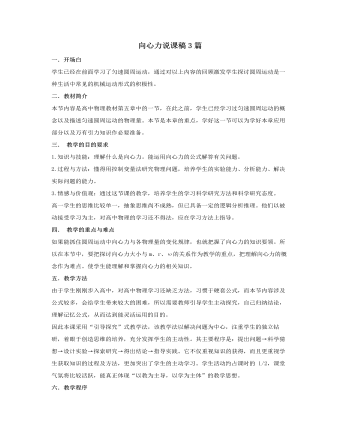
人教版新课标高中物理必修2向心力说课稿3篇
通过这个示例呢,我们可以得到解决向心力问题的一般的步骤,确定对象,找出轨迹,找出圆心,然后进行受力分析,让同学们参考这样的步骤,逐步的解决圆周运动的问题,对于变速圆周运动,我通过链球运动进行引入,这里是一个链球运动的视频,在同学们观看视频之前,我给同学们提出问题,链球收到绳子的拉力,做的是匀速圆周运动吗? 然后再课堂上我们再做一个小实验, 我们可以通过改变拉线的方式来调节小球的速度大小吗? 那么对小球,做加速圆周运动,进行受力分析,我们可以看到,小球做加速运动时,他所受到的力,并不是严格通过轨迹的圆心,在进行分析的时候,特别强调,小桶所受力的切线方向分力,和法线方向分力,切线方向分力,改变小球运动速度大小,法线方向分力,改变了小球运动的方向,法线方向的分力,在这里就是向心力,产生了向心加速度,通过这样一个例子进行分析,同学们是比较容易理解的,
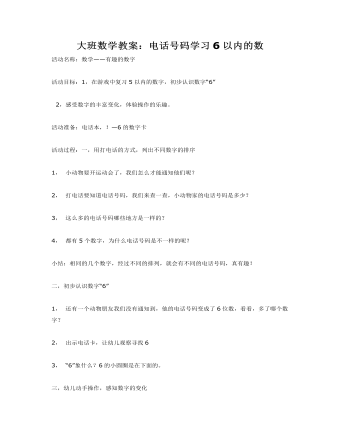
大班数学教案:电话号码学习6以内的数
活动准备:电话本,!—6的数字卡活动过程:一,用打电话的方式,列出不同数字的排序1, 小动物要开运动会了,我们怎么才能通知他们呢?2, 打电话要知道电话号码,我们来查一查,小动物家的电话号码是多少?3, 这么多的电话号码哪些地方是一样的?4, 都有5个数字,为什么电话号码是不一样的呢?小结:相同的几个数字,经过不同的排列,就会有不同的电话号码,真有趣!
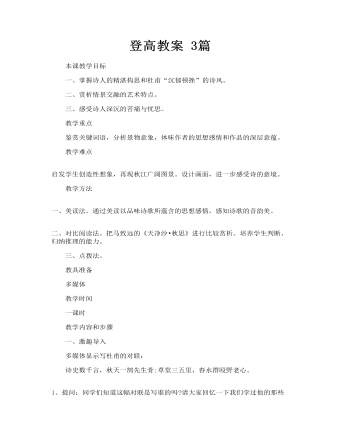
登高教案 3篇
一、激趣导入 多媒体显示写杜甫的对联: 诗史数千言,秋天一鹄先生骨;草堂三五里,春水群殴野老心。 1、提问:同学们知道这幅对联是写谁的吗?请大家回忆一下我们学过他的那些作品?能背诵一首我们共同欣赏吗?(学生背诵)今天我们来学习他的另一首诗歌《登高》(板书)
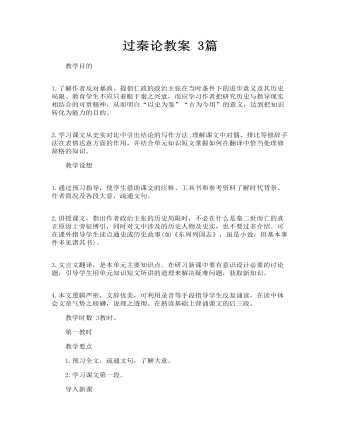
过秦论教案 3篇
1.通过预习指导,使学生借助课文的注释、工具书和参考资料了解时代背景、作者简况及各段大意,疏通文句。 2.讲授课文,指出作者政治主张的历史局限时,不必在什么是秦二世而亡的真正原因上旁征博引,同时对文中涉及的历史人物及史实,也不要过多介绍。可在课外指导学生读点通史或历史故事(如《东周列国志》,虽是小说,但基本事件多见诸其书)。
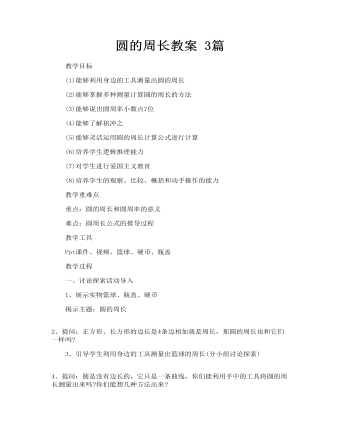
圆的周长教案 3篇
一、讨论探索活动导入 1、展示实物篮球、瓶盖、硬币 揭示主题:圆的周长 2、提问:正方形、长方形的边长是4条边相加就是周长,那圆的周长也和它们一样吗? 3、引导学生利用身边的工具测量出篮球的周长(分小组讨论探索) 4、提问:圆是没有边长的,它只是一条曲线,你们能利用手中的工具将圆的周长测量出来吗?你们能想几种方法出来?
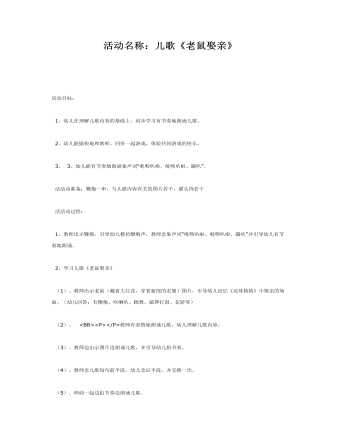
中班语言活动教案:老鼠娶亲
2、幼儿能愉快地和教师、同伴一起游戏,体验共同游戏的快乐。 3、 3、幼儿能有节奏地朗诵象声词“吡呖叭啦、吡呖叭啦、蹦叭”。 活活动准备:鞭炮一串,与儿歌内容有关的图片若干,猫头饰若干 活活动过程: 1、教师出示鞭炮,引导幼儿模仿鞭炮声,教师念象声词“吡呖叭啦、吡呖叭啦、蹦叭”并引导幼儿有节奏地朗诵。 2、学习儿歌《老鼠娶亲》 (1)、教师出示老鼠(戴着大红花,穿着新郎的衣服)图片,引导幼儿回忆《还珠格格》中娶亲的场面。(幼儿回答:有鞭炮、吹喇叭、跳舞、敲锣打鼓、花轿等) (2)、 <BR><P></P>教师有表情地朗诵儿歌,幼儿理解儿歌内容。

中班语言教案:鼹鼠爸爸的鼾声
活动过程: 一、谈话导入1、出示贴有幼儿爸爸调查表的展板:介绍自己爸爸的本领 小结:爸爸的本领真大,会开车、会……;爸爸真了不起!2、我也请来了一个爸爸,看看会是谁?(出示鼹鼠爸爸的图片) 二、理解故事1、画面一: (1)鼹鼠爸爸和你们的爸爸一样也有一个了不起的本领,瞧鼹鼠爸爸有什么本领呢?2、画面二:我们来看看有哪些小动物住进了鼹鼠爸爸造的房子?3、画面三~画面六: (1)鼹鼠爸爸工作了一天回到了家。猜猜鼹鼠宝宝会对鼹鼠爸爸说什么?听听它们是怎么说的? (2)怎么传来了震天响的呼噜声?
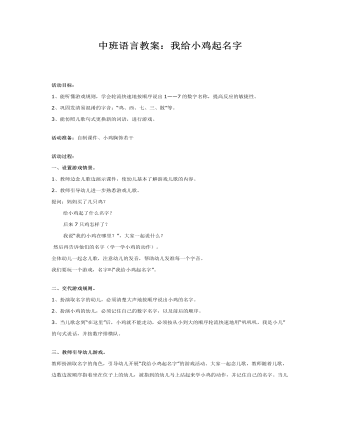
中班语言教案:我给小鸡起名字
活动准备:自制课件、小鸡胸饰若干活动过程:一、设置游戏情景。 1、教师边念儿歌边演示课件,使幼儿基本了解游戏儿歌的内容。 2、教师引导幼儿进一步熟悉游戏儿歌。 提问:妈妈买了几只鸡? 给小鸡起了什么名字? 后来7只鸡怎样了? 我说“我的小鸡在哪里?”,大家一起说什么? 然后再告诉他们的名字(学一学小鸡的动作)。 全体幼儿一起念儿歌,注意幼儿的发音,帮助幼儿发准每一个字音。 我们要玩一个游戏,名字叫“我给小鸡起名字”。二、交代游戏规则。 1、扮演取名字的幼儿,必须清楚大声地按顺序说出小鸡的名字。 2、扮演小鸡的幼儿,必须记住自己的数字名字,以及前后的顺序。 3、当儿歌念到“在这里”后,小鸡就不能走动,必须按从小到大的顺序轮流快速地用“叽叽叽,我是小几”的句式说话,并按数序排横队。
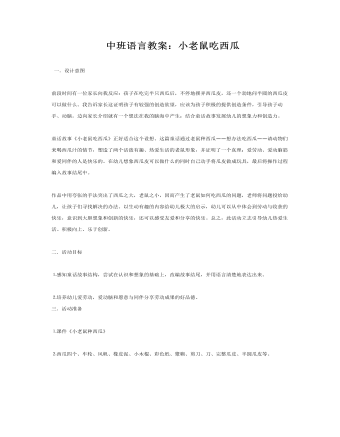
中班语言教案:小老鼠吃西瓜
二.活动目标⒈感知童话故事结构,尝试在认识和想象的基础上,改编故事结尾,并用语言清楚地表达出来。⒉培养幼儿爱劳动,爱动脑和愿意与同伴分享劳动成果的好品德。三.活动准备⒈课件《小老鼠种西瓜》⒉西瓜四个、车轮、风帆、橡皮泥、小木棍、彩色纸、漿糊、剪刀、刀、完整瓜皮、半圆瓜皮等。四.活动过程一、 欣赏故事⒈教师以提问的方法引出故事名称,引起幼儿注意。⒉讲述第一遍故事,边讲边播放 <BR><P></P>课件。(出现大西瓜和小老鼠在屏幕上,突出西瓜大、老鼠小)⒊讲述第二遍故事,边讲述边播放。(动画型式播放故事基本内容)

中班语言教案:秋天果子多(诗歌)
2.体验边手工粘贴边念儿歌的乐趣;3.乐意用普通话大胆、清楚地朗诵儿歌。活动重点:用普通话大胆、清楚的朗诵儿歌。活动难点:注意个别孩子在边手工粘贴边念儿歌的困难。活动准备:1.盘子一个2.各种水果
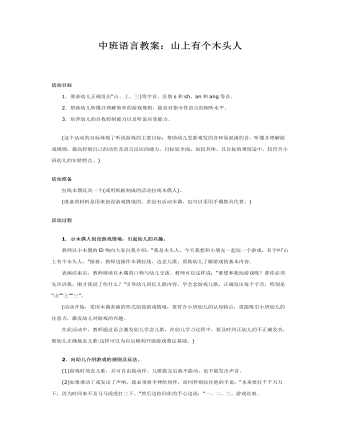
中班语言教案:山上有个木头人
活动准备 拉线木偶玩具一个(或用纸板制成的活动拉线木偶人)。(准备的材料是用来创设游戏情境的。若没有活动木偶,也可以采用手偶教具代替。)活动过程1.示木偶人创设游戏情境,引起幼儿的兴趣。 教师以小木偶的El吻向大家自我介绍:“我是木头人。今天我想和小朋友一起玩一个游戏,名字叫‘山上有个木头人。”接着,教师边操作木偶拉线,边念儿歌,帮助幼儿了解游戏的基本内容。 表演结束后,教师继续以木偶的口吻与幼儿交谈。教师可以这样说:“谁想和我玩游戏呢?那你必须先告诉我,刚才我说了些什么?”引导幼儿回忆儿歌内容,学会念游戏儿歌,正确发出每个字音,特别是“山”“上”“三”。(活动开始,采用木偶表演的形式创设游戏情境,更符合小班幼儿的认知特点,更能吸引小班幼儿的注意力,激发幼儿对游戏的兴趣。 在此活动中,教师通过语言激发幼儿学念儿歌,在幼儿学习过程中,要及时纠正幼儿的不正确发音,教幼儿正确地念儿歌·这样可以为以后顺利开展游戏奠定基础。)2.向幼儿介绍游戏的规则及玩法。(1)游戏时须念儿歌,并可自由做动作。儿歌做完后就不能动,也不能发出声音。(2)如果谁动了或发出了声响,就必须将手伸给同伴,而同伴则拉住他的手说:“本来要打千千万万下,因为时间来不及马马虎虎打三下。”然后边拍同伴的手心边说:“一、二、三。游戏结束。(听说游戏规则中一定要包含语言练习的要求,否则就不能达成语言学习的目标。此游戏规则中要求幼儿边念儿歌边进行游戏,这就充分体现了语言练习的要求。 对于小班幼儿来说,教师制定的规则一定要简单,语言也一定要简洁明了,以便于幼儿理解游戏的规则,基本了解游戏的玩法。)
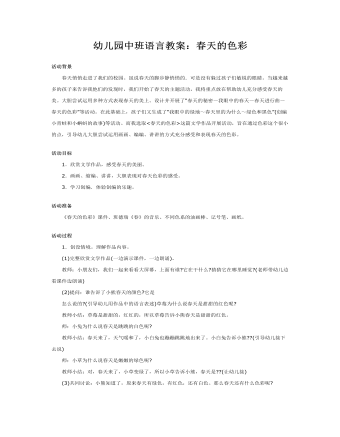
幼儿园中班语言教案:春天的色彩
活动目标1.欣赏文学作品,感受春天的美丽。2.画画、缩编、讲讲,大胆表现对春天色彩的感受。3.学习创编.体验创编的乐趣。活动准备 《春天的色彩》课件、班德瑞《春》的音乐、不同色系的油画棒、记号笔、画纸。活动过程1.创设情境。理解作品内容。(1)完整欣赏文学作品(一边演示课件,一边朗诵)。 教师:小朋友们,我们一起来看看大屏幕,上面有谁?它在干什么?猜猜它在哪里睡觉?(老师带幼儿边看课件边朗诵)

